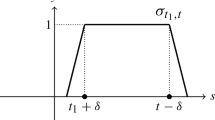Abstract
We provide bounds in a Sobolev-space framework for transport equations with nontrivial inflow and outflow. We give, for the first time, bounds on the gradient of the solution with the type of inflow boundary conditions that occur in Poiseuille flow. Following ground-breaking work of the late Charles Amick, we name a generalization of this type of flow domain in his honor. We prove gradient bounds in Lebesgue spaces for general Amick domains which are crucial for proving well posedness of the grade-two fluid model. We include a complete review of transport equations with inflow boundary conditions, providing novel proofs in most cases. To illustrate the theory, we review and extend an example of Bernard that clarifies the singularities of solutions of transport equations with nonzero inflow boundary conditions.







Similar content being viewed by others
References
Amick, C.J.: Steady solutions of the Navier–Stokes equations in unbounded channels and pipes. Annali della Scuola Normale Superiore di Pisa-Classe di Scienze 4(3), 473–513 (1977)
Bernard, J.-M.: Solutions globales variationnelles et classiques des fluides de grade deux. Comptes Rendus de l’Academie des Sciences - Series I - Mathematics 327, 953–958 (1998)
Bernard, J.-M.: Problem of second grade fluids in convex polyhedrons. SIAM J. Math. Anal. 44(3), 2018–2038 (2012)
Bernard, J.-M.: Steady transport equation in the case where the normal component of the velocity does not vanish on the boundary. SIAM J. Math. Anal. 44(2), 993–1018 (2012)
Bernard, J.-M.: Solutions in $H^1$ of the steady transport equation in a bounded polygon with a full non-homogeneous velocity. Journal de Mathématiques Pures et Appliquées 107(6), 697–736 (2017)
Bernard, J.-M.: Fully nonhomogeneous problem of two-dimensional second grade fluids. Math. Methods Appl. Sci. 41(16), 6772–6792 (2018)
Brenner, S.C., Scott, L.R.: The Mathematical Theory of Finite Element Methods, third Springer, Berlin (2008)
Choudhury, A.P., Crippa, G., Spinolo, L.V.: Initial-boundary value problems for nearly incompressible vector fields, and applications to the Keyfitz and Kranzer system. Zeitschrift für angewandte Mathematik und Physik 68(6), 138 (2017)
Cioranescu, D., Girault, V., Rajagopal, K.R.: Mechanics and Mathematics of Fluids of the Differential Type. Springer, Berlin (2016)
Girault, V., Scott, L.R.: Analysis of a two-dimensional grade-two fluid model with a tangential boundary condition. J. Math. Pures Appl. 78, 981–1011 (1999)
Girault, V., Scott, L.R.: On a time-dependent transport equation in a Lipschitz domain. SIAM J. Math. Anal. 42, 1721–1731 (2010)
Girault, V., Scott, L.R.: Oldroyd models without explicit dissipation. Rev. Roumaine Math. Pures Appl. 63(4), 401–446 (2018)
Girault, V., Scott, L.R.: Tanner duality between the Oldroyd–Maxwell and grade-two fluid models. Comptes Rendus—Mathématique 359(9), 1207–1215 (2021)
Girault, V., Tartar, L.: Régularité dans $L^p$ et $W^{1, p}$ de la solution d’une équation de transport stationnaire. Comptes Rendus. Mathématique 348(15–16), 885–890 (2010)
Lodge, A.S., Pritchard, W.G., Scott, L.R.: The hole-pressure problem. IMA J. Appl. Math. 46, 39–66 (1991)
Mucha, P.B., Piasecki, T.: Stationary compressible Navier–Stokes equations with inflow condition in domains with piecewise analytical boundaries. Pure Appl Anal 2(1), 123–155 (2019)
Nyström, M., Tamaddon Jahromi, H.R., Stading, M., Webster, M.F.: Hyperbolic contraction measuring systems for extensional flow. Mech. Time Depend. Mater. 21(3), 455–479 (2017)
Oliveira, P.J., Pinho, F.T.: Analytical solution for fully developed channel and pipe flow of Phan–Thien–Tanner fluids. J. Fluid Mech. 387, 271–280 (1999)
Otárola,E., Salgado, A.J.: On the analysis and approximation of some models of fluids over weighted spaces on convex polyhedra. Numerische Mathematik (2022)
Phan-Then, N., Tanner, R.I.: A new constitutive equation derived from network theory. J. Non Newton. Fluid Mech. 2(4), 353–365 (1977)
Piasecki, T.: Steady transport equation in Sobolev–Slobodetskii spaces. Colloq. Mathemat. 154, 65–76 (2018)
Pollock, S., Scott, L.R.: An algorithm for the grade-two rheological model. M2AN (accepted) (2022)
Pritchard, W.G.: Measurements of the viscometric functions for a fluid in steady shear flows. Philos. Trans. R. Soc. Lond Ser. A 302 270(1208), 507–556 (1971)
Schwartz, L.: Théorie des distributions. Hermann, Paris (1966)
Scott, L.R.: Introduction to Automated Modeling with FEniCS. Computational Modeling Initiative (2018)
Tanner, R.I.: The stability of some numerical schemes for model viscoelastic fluids. J. Non Newton. Fluid Mech. 10, 169–174 (1982)
Acknowledgements
SP is supported in part by the National Science Foundation NSF DMS-2011519. We thank the referees for valuable suggestions.
Author information
Authors and Affiliations
Corresponding author
Additional information
This article is part of the section “Theory of PDEs” edited by Eduardo Teixeira.
Spaces
Spaces
Here we collect the notation used for various Sobolev spaces and norms. We denote by \(L^p(\Omega )\) the Lebesgue spaces [7] of p-th power integrable functions, with norm
Note that we can easily apply the same notation to vector or tensor valued f. We think of tensors of any arity as vectors of the appropriate length, and we think of \(|f({{\mathbf {x}}})|\) as the Euclidean length of this vector. For tensors of arity 2 (i.e., matrices) this is the same as the Frobenius norm. We will write the spaces for such tensor-valued functions as \(L^p(\Omega )^m\) for the appropriate m (e.g., \(m=d^2\) for arity 2). Similarly, we denote by \(L^\infty (\Omega )\) the Lebesgue space of essentially bounded functions, with
Correspondingly, we define Sobolev spaces and norms of order m by
where \(D^\alpha \) is the weak derivative \(\partial ^\alpha /\partial {{\mathbf {x}}}^{|\alpha |}\) [7]. More precisely, the spaces \(W^m_p(\Omega )\) are defined as the subspaces of \(L^p(\Omega )\) for which the corresponding norm is finite. The case \(p=2\) is denoted by H:
Correspondingly, we define
Note that
We will briefly use the space \(H^1_0(\Omega )\) of \(f\in H^1(\Omega )\) such that \(f=0\) on \(\partial \Omega \). The dual space \(H^{-1}(\Omega )^d\) is the set of Schwartz distributions [24] for which the dual norm
is finite.
Rights and permissions
About this article
Cite this article
Scott, L.R., Pollock, S. Transport equations with inflow boundary conditions. Partial Differ. Equ. Appl. 3, 35 (2022). https://doi.org/10.1007/s42985-022-00169-0
Received:
Accepted:
Published:
DOI: https://doi.org/10.1007/s42985-022-00169-0



